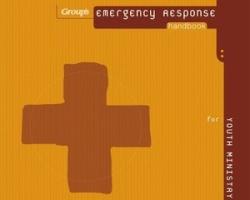Group Publishing
Group, 2007, 147 pp., $14.99
Group’s Emergency Response Handbook is a resource that gives a very brief overview of how to handle difficult situations that teens in your youth group may face. Chapter emphases include things such as: dealing with divorce, how to handle a teen who has been abused, what to do when teens contemplating are suicide, how to console those who are grieving, steps to take in case of addiction, etc. Each chapter gives an example of the situation being discussed, counseling advice, ministry tips, suggestions of helpful things to say (and not to say!), and a short list of book and online resources for more information on the topic. I would expect youth pastors to know most of the information provided here if they went to Bible college or seminary. However, people who are not experts in the subjects of counseling or pastoral care would find this book helpful because it helps the reader work through the initial reaction of, “Help! What do I do?” The book gives clues about how to recognize crises in teens’ lives and provides tips about how to point them in the right direction. While the book does not go into great depth or give a complete and detailed list of resources, it is a great starting point. I would recommend this book for youth pastors to use as a preparation tool when training youth workers. It gives good examples and would be helpful for opening discussion on topics that some people are afraid to cover. I also recommend the youth pastor/leader keep a more extensive list of local organizations and resources on hand in conjunction with the book.
—Rachel Galarneau, Youth Leader, Springfield, Ohio
Group’s Emergency Response Handbook has been a great resource not only for me and my adults since it was first published in 2007, but also for my students. During the past five years, I have had numerous students borrow it to help their friends who were going through pregnancy, depression, divorce and other issues. In my mind, that is a great testimony of how useful and great this resource is in ministry; and at such a low price through any Christian retailer or online, you can’t beat this deal for the great resource it is. Do yourself a favor as I did and buy a bulk order every year for your adult volunteers and student leaders!
—Eric Hendrickson, follow me on Twitter
This resource I already had, but I love it so much I am glad to spread the joy. If you’re in youth ministry for longer than 15 minutes, chances are you will experience a teen in crisis. I’m not talking about middle school girl crises which come and go like weird outfits from Lady Gaga. This book covers everything from suicide intervention to crisis pregnancy, academic problems to gender issues. This won’t make you a trained counselor, but you’re going to feel as if you could be. Each section comes with counseling background, as well as tips and ideas. This is a book you’ll want to read early and often in ministry. I like it so much I have a copy on my Kindle. Crisis doesn’t come planned, so preparation is key here. Obviously this is for use with teens in crisis, so one idea would be to make each section a leadership training time and talk through your leader’s specific skills for your setting and group. For clarification, just because you aren’t a middle school girl anymore (or never were!), don’t assume their grief isn’t a crisis. This book should be in the hands of every youth worker.
—Rick Nier, Pastor of Youth & Christian Education, Winona Lake Free Methodist Church
Group’s Emergency Response Handbook for Youth Ministry provides a very accessible resource for youth ministers dealing with teens in a variety of crises. The authors explore many common issues within youth culture such as addiction, divorce, grief, depression and family conflict. Each topic receives thorough exploration through case studies, care tips, guidance on referral and areas where Scripture confronts the issue being discussed. The section titled “Group Tips” within each individual topic is particularly helpful as leaders consider how to lead concerned members of the youth ministry in reaching out to students struggling with the issues covered within the book. The sections regarding what not to say and what to say are also very helpful as they help leaders frame their responses in love and understanding rather than judgment. The additional resource suggestions at the conclusion of each unit are also helpful as many youth ministers are so busy with the many requirements of ministry that a quick reference library often is not available. The providers of this resource are to be applauded for keeping it brief yet usable. Many similar tools are quite large and bulky. This tool can be thrown in a bag and taken on various trips and retreats. Youth pastors will find this resource abundantly helpful for its applicability and usability.
—Joel Jackson
###




